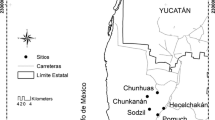Abstract
Research on agrobiodiversity points to the importance of home gardens in situ conservation, yet few studies to date explicate the origins and dynamics of plant species diversity. In this paper, we examine inter-household variations in cultivated plant species diversity among house gardens in a traditional peasant community, near Iquitos, Peru. In-depth household interviews (n = 24) and garden/field surveys reveal that home gardens are clearly the site of highest plant diversity in farmers’ field portfolios, and that substantial differences exist in garden composition, plant diversity, and the sources of garden planting material across households. Statistical analyses indicate that home garden diversity is related strongly to specific garden characteristics, household socioeconomic features, and access to planting material including seeds, cuttings, and suckers. The role and implications of differential access to planting material in the development and maintenance of crop species diversity is signaled as an important theme for future study in economic botany.
Similar content being viewed by others
Literature Cited
Alavalapati, J. R. R., M. K. Luckert, andD. S. Gill. 1995. Adoption of agroforestry practices: A case study from Andhra Pradesh, India. Agroforestry Systems 32:1–14.
Alcorn, J. B. 1992. Indigenous agroforestry systems in the Latin American tropics. Pages 203–218 in M. A. Altieri and S. B. Hecht, eds., Agroecology and small farm development. CRC Press, Boston.
Alvarez-Buylla Roces, M. E., E. Lazos Chavero, andJ. R. García-Barrios. 1989. Homegardens of a humid tropical region in Southeast Mexico: An example of an agroforestry cropping system in a recently established community. Agroforestry Systems 8:133–156.
Brierly, J. S. 1976. Kitchen gardens in the West Indies, with a contemporary study from Grenada. Journal of Tropical Geography 43:30–40.
Caballero, J. 1992. Maya home gardens: Past, present and future. Etnoecológica 1(1):35–55.
Chibnik, M. 1994. Risky rivers: The economics and politics of floodplain farming in Amazonia. University of Arizona Press, Tucson.
Clarke, W. C., andR. R. Thaman, eds. 1993. Agroforestry in the Pacific islands: Systems for sustainability. United Nations Press, New York.
Coomes, O. T. 1998. Traditional peasant agriculture along a blackwater river of the Peruvian Amazon. Revista Geográfica 124:33–55.
—, andG. J. Burt. 1997. Indigenous market-oriented agroforestry: Dissecting local diversity in western Amazonia. Agroforestry Systems 37:27–44.
—,F. Grimard, andG. J. Burt. 2000. Tropical forests and shifting cultivation: Secondary fallow dynamics among traditional farmers of the Peruvian Amazon. Ecological Economics 32:109–124.
Esquivel, M., andK. Hammer. 1992. The Cuban homegarden ‘conuco’: A perspective environment for evolution and in situ conservation of plant genetic resources. Genetic Resources and Crop Evolution 39:9–22.
Gómez-Pompa, A. 1996. Three levels of conservation by local people. Pages 347-356 in F. Di Castri and T. Younés, eds., Biodiversity, science and development: Towards a new partnership. CAB International, Wallingford, UK.
Guillaumet, J-L., P. Grenand, S. Bahri, F. Grenand, M. Lourd, A. A. do Santos, andA. Gély. 1990. Les jardins-vergers familiaux d’ Amazonie centrale: un example d’utilisation de l’espace. Turrialba 40(l):63–81.
Hamlin, C. C., and J. Salick. 2003. Yanesha agriculture in the upper Peruvian Amazon: Persistence and change fifteen years down the ‘road’. Economic Botany 57(2): 163–180.
Hills, T.L. 1988. The Caribbean food forest, ecological artistry or random chaos. Pages 1-28 in J. S. Brierley and H. Rubenstein, eds., Small farming and peasant resources in the Caribbean. Manitoba Geographical Studies 10, Winnipeg, Canada.
Hiraoka, M. 1985. Changing floodplain livelihood patterns in the Peruvian Amazon. Tsukuba Studies in Human Geography 9:243–275.
Hiraoka, M.. 1986. Zonation of mestizo riverine farming systems in Northeast Peru. National Geographic Research 2:354–371.
Johnson, A.W. 1972. Individuality and experimentation in traditional agriculture. Human Ecology 1(2): 149–160.
Kimber, C. 1978. A folk context for plant domestication: Or the dooryard garden revisited. Anthropological Journal of Canada 16(4):2–11.
Kumar, B. M., S. J. George, andS. Chinnamani. 1994. Diversity, structure and standing stock of wood in the homegardens of Kerala in Peninsular India. Agroforestry Systems 25(3):243–262.
Lamont, S. R., W. H. Eschbaugh, andA. M. Greenberg. 1999. Species composition, diversity, and use of homegardens among three Amazonian villages. Economic Botany 53(3):312–26.
Lerch, N. 2000. Home gardens, cultivated plant diversity, and exchange of planting material in the Pacaya-Samiria National Reserve area, northeastern Peru. Unpublished M.A. thesis, McGill University, Montreal.
Merrick, L. C. 1992. Crop genetic diversity and its conservation in traditional agroecosystems. Pages 3-11 in M.A. Altieri and S.B. Hecht, eds., Agroecology and small farm development. CRC Press, Boston.
Oré Balbin, I., andD. Llapapasca Samaniego. 1996. Huertas domesticas como sistema tradicional de cultivo en Moena Caño, Rio Amazonas, Iquitos, Pera. Folia Amazonica 8(l):91–110.
Padoch, C. 1988. People of the floodplain and forest. Pages 127-140 in J. S. Denslow and C. Padoch, eds., People of the tropical rain forest. University of California Press, Berkeley.
—,J. Chota Inuma, W. de Jong, andJ. Unruh. 1985. Amazonian agroforestry: A market-oriented system in Pera. Agroforestry Systems 3(l):47–58.
—. 1991. The house gardens of Santa Rosa: Diversity and variability in an Amazonian agricultural system. Economic Botany 45:166–175.
Rico-Gray, V., J. G. Garda-Franco, A. Chemas, A. Puch, andP. Sima. 1990. Species composition, similarity, and structure of Mayan homegardens in Tixpeual and Tixcacaltuyub, Yucatan, Mexico. Economic Botany 44:470–487.
Smith, N. J. H. 1996. Home gardens as a springboard for agroforestry development in Amazonia. International Tree Crops Journal 9:11–30.
—,T. J. Fik, P. T. Alvim, I. C. Falesi, andE. A. S. Serrão. 1995. Agroforestry developments and potential in the Brazilian Amazon. Land Degradation and Rehabilitation 6:251–263.
Zaldivar, M. E., O. J. Roach, E. Castro, andR. Barrantes. 2002. Species diversity of edible plants grown in homegardens of Chibchan Amerindians from Costa Rica. Human Ecology 30(3):301–316.
Zimmerer, K. 1991. Labor shortages and crop diversity in the southern Peruvian sierra. The Geographical Review 82(4):414–432.
Author information
Authors and Affiliations
Corresponding author
Rights and permissions
About this article
Cite this article
Coomes, O.T., Ban, N. Cultivated plant species diversity in home gardens of an Amazonian peasant village in Northeastern Peru. Econ Bot 58, 420–434 (2004). https://doi.org/10.1663/0013-0001(2004)058[0420:CPSDIH]2.0.CO;2
Received:
Accepted:
Issue Date:
DOI: https://doi.org/10.1663/0013-0001(2004)058[0420:CPSDIH]2.0.CO;2




